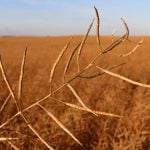Canadian farm cash receipts for the January to September period have increased for the seventh consecutive year, Statistics Canada reports.
Those receipts totalled $45.4 billion in the first three quarters of the year, a 3.3 percent increase from that same period in 2016.
Farm cash receipts are not the same as net farm income, but the rising figures show a positive trend, said Canadian Federation of Agriculture president Ron Bonnett.
“I think it demonstrates that there’s still growth taking place and there’s increased income in the sector, but there is some variability once you dig into the numbers, whether it be by crops or by region,” said Bonnett.
Read Also

Lower nitrogen rates in dry beans could pay off for farmers
Manitoba research is testing whether reduced nitrogen fertilizer in dry beans can maintain yields while cutting costs and lowering greenhouse gas emissions.
Alberta had the highest level at $10.9 billion in farm cash receipts, up six percent from the January to September 2016 period.
Saskatchewan was close behind, realizing $10.4 billion (up 3.6 percent). Manitoba had $4.8 billion (up 7.5 percent) and British Columbia had $2.3 billion (up 1.5 percent).
On the crop side, Canadian farm receipts increased by $628 million, Statistics Canada reported, attributing it primarily to canola and wheat income that offset declines in lentils and soybeans.
Canola led the income field, generating $7.2 billion in receipts from 14 million tonnes in the first nine months of 2017. That’s an increase of almost 10 percent over the same period in 2016.
Wheat excluding durum earned $3.8 billion, an 11.6 percent increase.
“Average prices were down year over year in the first and second quarters but rose 13.5 percent in the third quarter compared with the same period in 2016 as concerns increased about a shortage of good quality wheat,” Statistics Canada said in its report.
However, lentils took a major hit with receipts declining by 17.3 percent because of reduced prices.
Livestock receipts, at $18.4 billion for the first nine months of 2017, were up by $419 million compared to the same 2016 period.
Statistics Canada attributed much of that increase to supply managed sectors, especially dairy, which increased by $318 million over the previous year. Chicken and egg receipts also rose, contributing to an overall 5.2 percent increase in supply managed sectors.
“Yes, revenue for supply management was up, which demonstrates that they have the ability to negotiate prices with the buyers and make it happen,” said Bonnett.
Farm cash receipts also include program payments, he said, which means that gains in supply management sectors are made without any program payments available to other commodity sectors.
Hog receipts rose 7.6 percent over 2016, the equivalent of $245 million, due to higher prices and marketings. However, cattle and calf receipts declined by 2.8 percent, or $186 million.
“A 5.9 percent increase in the number of head slaughtered domestically was not enough to offset a 16.6 percent decline in the number of animals exported, combined with a 10.4 percent decline in the average export price,” Statistics Canada said.
Program payments accounted for $1.8 billion in total farm cash receipts, an increase of almost 30 percent over the first nine months of 2016.
More than half of that increase was generated in crop insurance payments, particularly in Saskatchewan, where claims were up after a nasty harvest season.
Overall, Bonnett said the latest figures reflect an encouraging trend in Canadian agriculture.
“Producers, it doesn’t matter what commodity, they’re becoming more and more efficient at the use of, particularly, crop inputs. Targeting fertilizer application, targeting pesticide use, using a lot of new technology, whether it be GPS technology or technology to really control the applications rates on crops,” he said.
“It’s helped lower some of the costs per unit, so my gut feeling is that with the increased farm cash receipts and the adoption of the technology, it should help with the final bottom line as well.”















